
When people return home from a vacation, they can get the blues, a hangover from the trip unrelated to any spirits they may have consumed. It’s that depressing realization that even though you just had a positive experience you’d been looking forward to and a necessary break from work and the routine, that’s over now, and it’s back to the grind.
In the weeks leading up to the Calgary Expo at the end of April, I had no shortage of motivation. There was plenty to do with a specific goal and a big event on the horizon. My tasks were clear, as was the deadline. The show arrived, the effort paid off, and it was a big success.
Usually, after the Expo, I feel inspired to paint, and that held true this time for about a week. This year, however, I got the hangover.
Now what?
So, I was in a bit of an emotional trough in May, which is unusual since I’m often peppy in spring. I’m out on the bike almost daily, as regular exercise is recommended for a lack of optimism. I was still up early to work, but there was a lot of heavy sighing and staring out the window, trying to figure out where to put my limited creative energy for both financial security and artistic fulfillment.
I’ve always got the daily cartoon deadlines and projects on which to work, but it can often be difficult to focus without specific targets.
However, at the end of May, I was accepted for four three-day weekends of the Banff Christmas Market in November and December. And last week, I finalized agreements for two pet portrait commissions. One is a large, active dog with a comical personality, and the other a memorial piece for the smallest dog I’ve yet painted. He was adorable and obviously very loved.
A commission painting is a big responsibility, one I don’t take lightly. It’s a privilege and honour that anybody would choose my style and work to capture their furry family member in a painting, especially for a memorial.
I’ve never painted two commissions at once for two different clients, but each is a welcome challenge. Both clients were fully engaged in the initial back and forth, and I’ve begun with a clear idea of what each is looking for. They offered suggestions, preferences and details that will make for better paintings. That’s always a great start.
 The paintings I was already working on need to be done by the end of next month so I can order puzzles and products for the markets. Then there are the sketches, paintings and writing for the book, six editorial cartoons each week, and now two commissions. Finally, there’s the ongoing marketing and admin stuff that’s a lot more work than most realize when they choose self-employed artist as a profession.
The paintings I was already working on need to be done by the end of next month so I can order puzzles and products for the markets. Then there are the sketches, paintings and writing for the book, six editorial cartoons each week, and now two commissions. Finally, there’s the ongoing marketing and admin stuff that’s a lot more work than most realize when they choose self-employed artist as a profession.
For anyone considering that leap, I can sum up the past 25+ years of my career as follows: Creating art is easy. Selling it is hard.
Suddenly, I have a very full plate for the next three or four months, with timelines and deadlines to keep me on track. I’m grateful to have so much to do, especially since a big chunk of it is creating artwork that might make people a little happier.
Hearing people in their fifties start talking about retirement is normal, but I have no such plans. What would I do without my work, finally have time to explore some artistic and creative pursuits?
It’s not hard to find articles and online posts that talk about work-life balance. While it might seem like an encouraging message, to slow down and relax, the pressure often makes people feel worse about their lives, not better. The guilt that comes with some stranger telling you that you’re doing your life wrong is just one more brick added to the load you already carry.
Being told we must pursue a better work-life balance isn’t a carrot. It’s a stick.
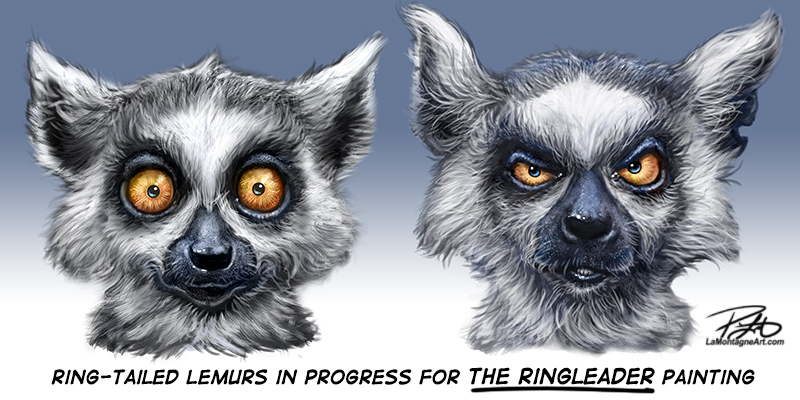 Sure, I’ll bitch about being too busy sometimes, but I chose this. Though the landscape will change, as will the work, and it’s unlikely ever to get easier, I plan to create art as long as possible. I don’t know if I could do anything else, now.
Sure, I’ll bitch about being too busy sometimes, but I chose this. Though the landscape will change, as will the work, and it’s unlikely ever to get easier, I plan to create art as long as possible. I don’t know if I could do anything else, now.
Shonna puts up with a lot, living with an anxious, moody, high-strung, obsessive-compulsive artist. But without my creative work to keep me busy, I’m sure I’d wake up one morning with a pillow hovering over my face.
Justifiable. Case dismissed.
I’ve often read variations of phrases like ‘your work is not your life,’ a caution to be careful how much time you devote to your job. But I don’t know who I am without my work. It’s the best part of me. I’m terrified of the day that age or something else robs me of my ability.
So, I’m going to continue to maintain my fitness and health, keep my head on a swivel while biking and driving, and hope to avoid the fickle finger of fate and the things I don’t see coming so I can keep drawing, painting and writing as long as I can.
Be who you are, people. We’re only here for a little while.
____
Dave and Martha discovered my art in Victoria several years ago, and getting emails from them is always nice. Usually, they might send a kind comment or something encouraging after A Wilder View shows up in their inboxes. They’re my parents’ age; their son and I were born in the same month and year, a detail they’d shared a while ago.
They’re currently on a road trip from their home in Washington, and these long-time collectors and supporters of my whimsical wildlife art have been here in the Canadian Rockies this week. It was great to meet them in person, and we had an enjoyable visit over coffee on Sunday.
When Dave described what they’d be wearing so I’d recognize them, he mentioned that he was bald. Though I saw them right away while locking my bike, I joked that I was looking for a bald guy, and he was wearing a hat. He shot back that I was greyer than he expected.
OK, I had that coming.
I’ve known for a while that I must spend an hour painting an ‘update’ to my self-portrait to account for more salt in that pepper, especially in my beard.
 I’m grateful for so many of you who follow my work, comment on my posts or write emails, sending me wildlife pictures and thoughts about something I’ve shared or the artwork in general. With so much content available to us, that anyone volunteers to receive my emails is humbling. It’s cliché to say that I wouldn’t be able to create art for a living without the support of people who enjoy it, but it’s true. So, feel free to reach out anytime, comment on a post, or just say Hello.
I’m grateful for so many of you who follow my work, comment on my posts or write emails, sending me wildlife pictures and thoughts about something I’ve shared or the artwork in general. With so much content available to us, that anyone volunteers to receive my emails is humbling. It’s cliché to say that I wouldn’t be able to create art for a living without the support of people who enjoy it, but it’s true. So, feel free to reach out anytime, comment on a post, or just say Hello.
But please, no politics or news links, fake or otherwise. I see way more of that than I want to in the other part of my work.
Thanks for the visit, Dave and Martha. Though you worried you might have been intruding on my time, it was truly my pleasure. Have a safe trip home.
.


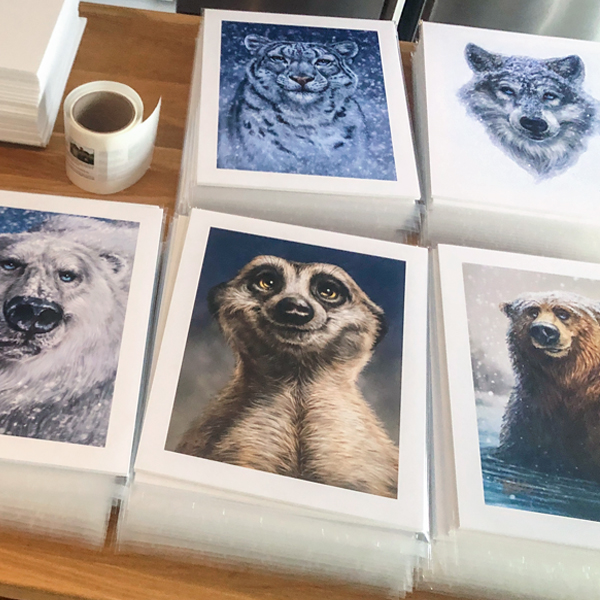













 I’ve also completed the bulk of my year-end bookkeeping this week and cleaned my office so I can start the new year right. I typically don’t make New Year’s resolutions, but I always have plans for the coming year.
I’ve also completed the bulk of my year-end bookkeeping this week and cleaned my office so I can start the new year right. I typically don’t make New Year’s resolutions, but I always have plans for the coming year.

 Trade shows and gift markets share similarities, but each is unique. Many vendors travel from one to the next each season. They know each other as coworkers and are on familiar terms with the organizers in different towns and venues. I always learn a lot from talking with these more experienced vendors, and I haven’t met one yet who wasn’t willing to share helpful information.
Trade shows and gift markets share similarities, but each is unique. Many vendors travel from one to the next each season. They know each other as coworkers and are on familiar terms with the organizers in different towns and venues. I always learn a lot from talking with these more experienced vendors, and I haven’t met one yet who wasn’t willing to share helpful information. You’ll have to forgive the blown-out sections of these photos where my phone camera overcompensated for the low light/spotlights.
You’ll have to forgive the blown-out sections of these photos where my phone camera overcompensated for the low light/spotlights. The vendors around me were friendly and fun to talk with, and since my booth for the next weekend is right beside the one I just vacated, I look forward to seeing these folks again soon.
The vendors around me were friendly and fun to talk with, and since my booth for the next weekend is right beside the one I just vacated, I look forward to seeing these folks again soon. Of course, my whole reason for attending the market was to sell my work, and sales were very good. Over three days, more than 7000 people came through the venue. Though it came and went in waves, it was a steady stream of people, likely because they admit 100 an hour via timed
Of course, my whole reason for attending the market was to sell my work, and sales were very good. Over three days, more than 7000 people came through the venue. Though it came and went in waves, it was a steady stream of people, likely because they admit 100 an hour via timed 
 Winter reared its ugly head this week in Alberta, and I’m already feeling the blues. It happens every year, but painting a happy face usually puts me in a better mood. Grizzly Bearapy. It’s an effective prescription.
Winter reared its ugly head this week in Alberta, and I’m already feeling the blues. It happens every year, but painting a happy face usually puts me in a better mood. Grizzly Bearapy. It’s an effective prescription.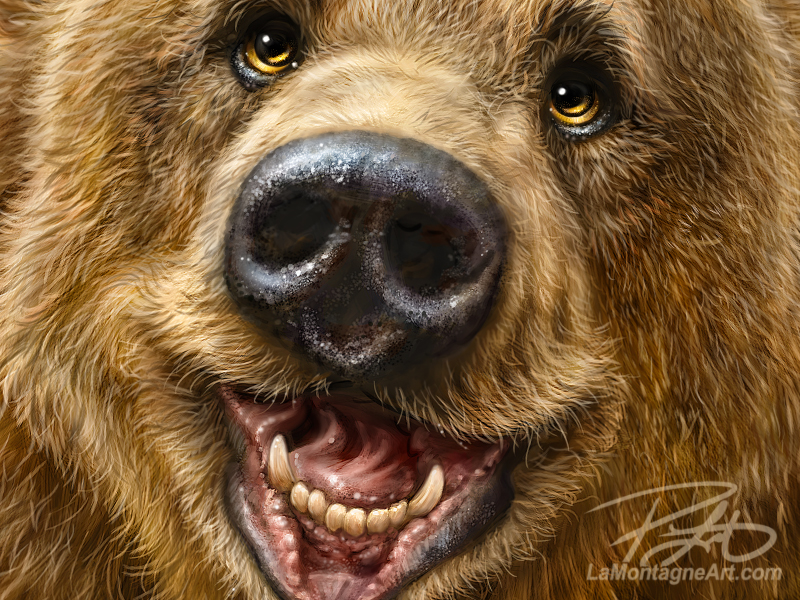 Though this painting was fun to do, as are most of my whimsical wildlife pieces, it was a commercial decision. It’s the first in a series of paintings I’m creating to promote my work to new licensing clients. It’s also another painting for the bear book.
Though this painting was fun to do, as are most of my whimsical wildlife pieces, it was a commercial decision. It’s the first in a series of paintings I’m creating to promote my work to new licensing clients. It’s also another painting for the bear book.
 While I’m not a big fan of the season, I love winter colours, the blues, greys and whites. Seems like I’m on a bit of a
While I’m not a big fan of the season, I love winter colours, the blues, greys and whites. Seems like I’m on a bit of a 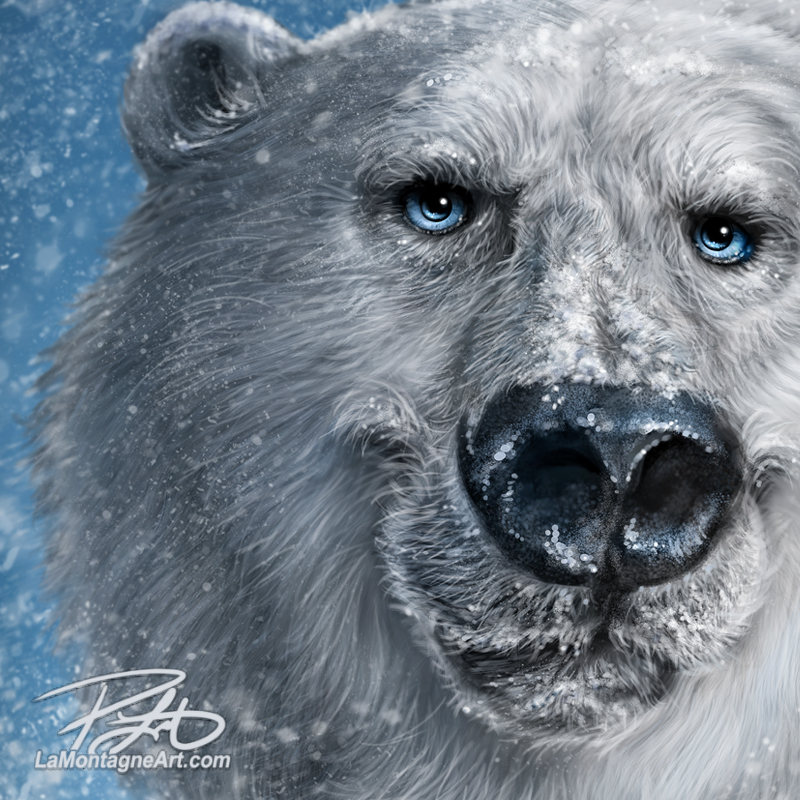 My friend
My friend 
 One of the challenges with a square format painting is that I need to crop it for my standard 11”x14” print, either vertical or horizontal. I tried both layouts, and vertical was the clear winner. Of course, you can always order the original square format as a canvas or metal print.
One of the challenges with a square format painting is that I need to crop it for my standard 11”x14” print, either vertical or horizontal. I tried both layouts, and vertical was the clear winner. Of course, you can always order the original square format as a canvas or metal print. 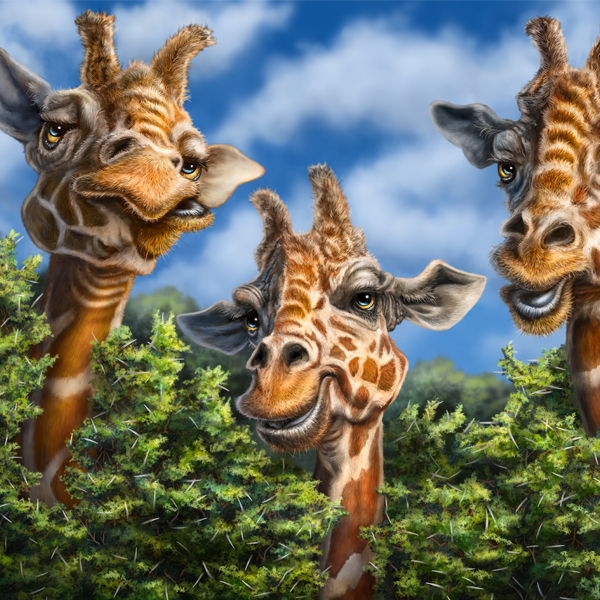
 While labour-intensive, this painting wasn’t especially difficult. There weren’t any parts of it where I worried I might not have the necessary skills. That comes from experience, the feeling that “it’ll take a while, but I got this.”
While labour-intensive, this painting wasn’t especially difficult. There weren’t any parts of it where I worried I might not have the necessary skills. That comes from experience, the feeling that “it’ll take a while, but I got this.” I began the project with several sketches and refined those into this mockup.
I began the project with several sketches and refined those into this mockup.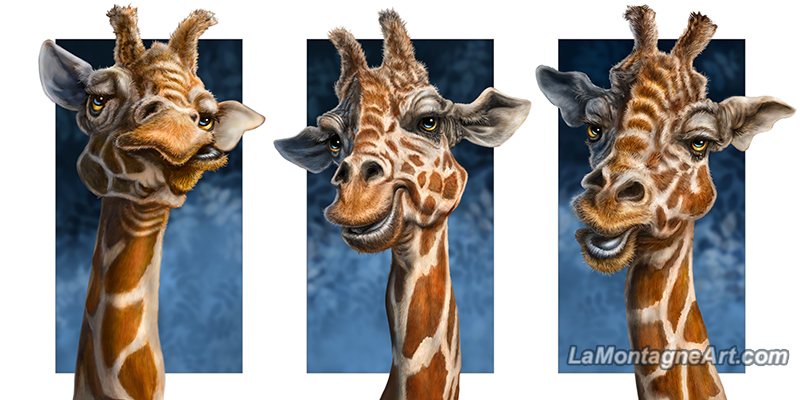 Then I painted the individual giraffes, creating three expressions different enough to be their own characters, but I still had to match the colours, light and shadow so they belonged together in the scene. Each giraffe could have been a single painting.
Then I painted the individual giraffes, creating three expressions different enough to be their own characters, but I still had to match the colours, light and shadow so they belonged together in the scene. Each giraffe could have been a single painting. Painting the environment was the most challenging part. I could have gone with generic-looking green deciduous leaves, and most people wouldn’t have cared. Even though my style of art is whimsical, and I take liberties with exaggeration and expression, I still try for accuracy in the anatomy and environment.
Painting the environment was the most challenging part. I could have gone with generic-looking green deciduous leaves, and most people wouldn’t have cared. Even though my style of art is whimsical, and I take liberties with exaggeration and expression, I still try for accuracy in the anatomy and environment. I don’t use any colour dynamics in my brushes. I prefer to pick and choose colour while painting, sampling from adjacent colours to get a better blend.
I don’t use any colour dynamics in my brushes. I prefer to pick and choose colour while painting, sampling from adjacent colours to get a better blend. These new brushes allowed me to create a solid foundation, but it looked flat and lifeless until I spent several hours painting light, shadow, and detail to achieve the finished result.
These new brushes allowed me to create a solid foundation, but it looked flat and lifeless until I spent several hours painting light, shadow, and detail to achieve the finished result. New digital artists often get obsessed with buying brush packs, thinking that’s all they need to achieve the same look as more experienced artists. But professional tools won’t provide a shortcut past the years of work it takes to become good at anything.
New digital artists often get obsessed with buying brush packs, thinking that’s all they need to achieve the same look as more experienced artists. But professional tools won’t provide a shortcut past the years of work it takes to become good at anything. While I called it Long Neck Buds, someone could easily interpret them as two parents and a child. People often tell me what one of my paintings is ‘thinking’ or what their expression means, and I wouldn’t dream of contradicting them. If the art makes them feel something or triggers their imagination, that’s good enough for me.
While I called it Long Neck Buds, someone could easily interpret them as two parents and a child. People often tell me what one of my paintings is ‘thinking’ or what their expression means, and I wouldn’t dream of contradicting them. If the art makes them feel something or triggers their imagination, that’s good enough for me.

 It’s been a busy week of post-show inventory, filling custom orders, drawing editorial cartoons and stowing my stock and booth hardware, but that’s normal after my biggest event of the year.
It’s been a busy week of post-show inventory, filling custom orders, drawing editorial cartoons and stowing my stock and booth hardware, but that’s normal after my biggest event of the year. It still pushes the childhood buttons when a fully functional R2-D2 glides by my booth. With a rotating head, lights, whistles and sound effects, panels that open and close, and full mobility, it looks and behaves like the real thing. I even know the guy who manufactured it; I used to work for him years ago in Canmore. So I know he’s running it by remote control from about ten feet away, that it’s all mechanical gears, parts, and wires. But the illusion that it’s the beloved movie character is strong.
It still pushes the childhood buttons when a fully functional R2-D2 glides by my booth. With a rotating head, lights, whistles and sound effects, panels that open and close, and full mobility, it looks and behaves like the real thing. I even know the guy who manufactured it; I used to work for him years ago in Canmore. So I know he’s running it by remote control from about ten feet away, that it’s all mechanical gears, parts, and wires. But the illusion that it’s the beloved movie character is strong.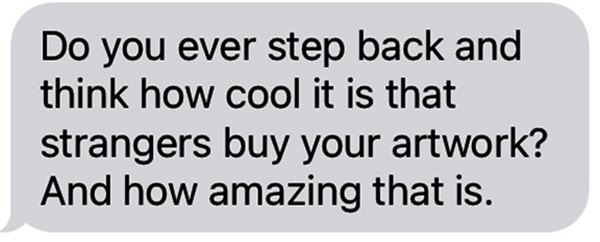
 Several folks stopped by to tell me that their friend or family member couldn’t make it to Expo this year, but they wanted them to say Hello for them.
Several folks stopped by to tell me that their friend or family member couldn’t make it to Expo this year, but they wanted them to say Hello for them. People walk by the booth, their eyes scan the art walls, and they smile. Then they nudge whoever they’re with and point, and the smile infects that person, too. I’ve talked about this before, but it’s like a drug. I can’t get enough of it.
People walk by the booth, their eyes scan the art walls, and they smile. Then they nudge whoever they’re with and point, and the smile infects that person, too. I’ve talked about this before, but it’s like a drug. I can’t get enough of it.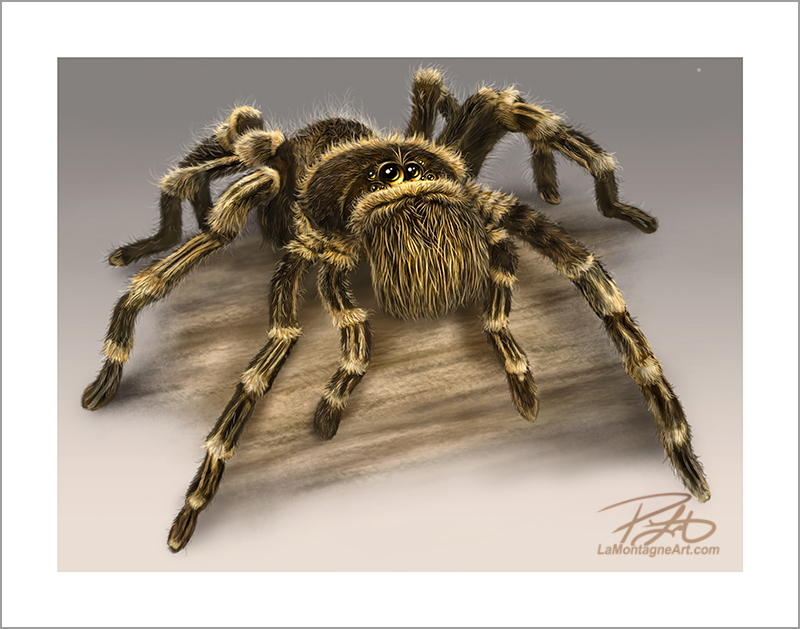 And, of course, it wouldn’t be Expo without a well-meaning follower reminding me that I am long overdue on my promise of a book. Imposter syndrome, perfectionism, I don’t know what my problem is there. My failure to launch bothers me more than anybody else. But the push is well deserved, Kim! Thank you for that.
And, of course, it wouldn’t be Expo without a well-meaning follower reminding me that I am long overdue on my promise of a book. Imposter syndrome, perfectionism, I don’t know what my problem is there. My failure to launch bothers me more than anybody else. But the push is well deserved, Kim! Thank you for that.

 If you’ve followed my work for a long time (hey, thank you!), you’ll know how much I look forward to the
If you’ve followed my work for a long time (hey, thank you!), you’ll know how much I look forward to the 
 I redesigned my booth last year and it worked so well for me, that I’m making no changes, except that I have invested in new lighting this year. As there was a pillar behind me, rather than another booth, I was able to expand a couple of feet. But I’ve got vendors right up against me on both sides this year, so I’ll have to stick to my 10’x10’ footprint.
I redesigned my booth last year and it worked so well for me, that I’m making no changes, except that I have invested in new lighting this year. As there was a pillar behind me, rather than another booth, I was able to expand a couple of feet. But I’ve got vendors right up against me on both sides this year, so I’ll have to stick to my 10’x10’ footprint.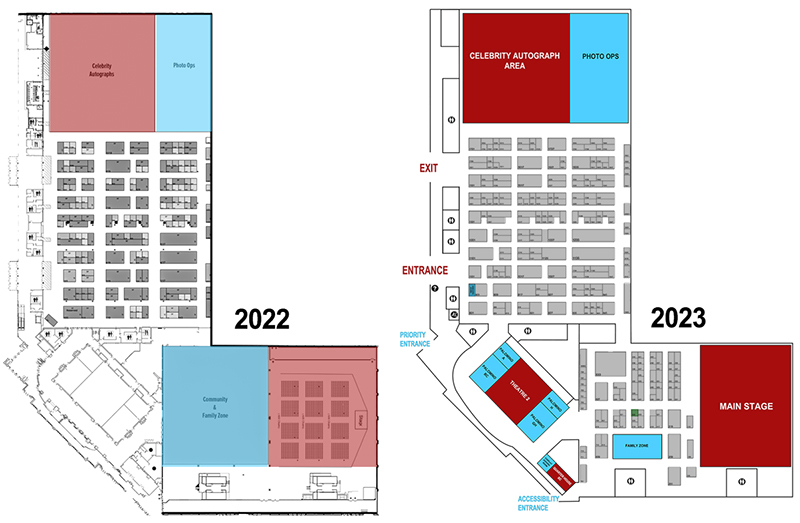
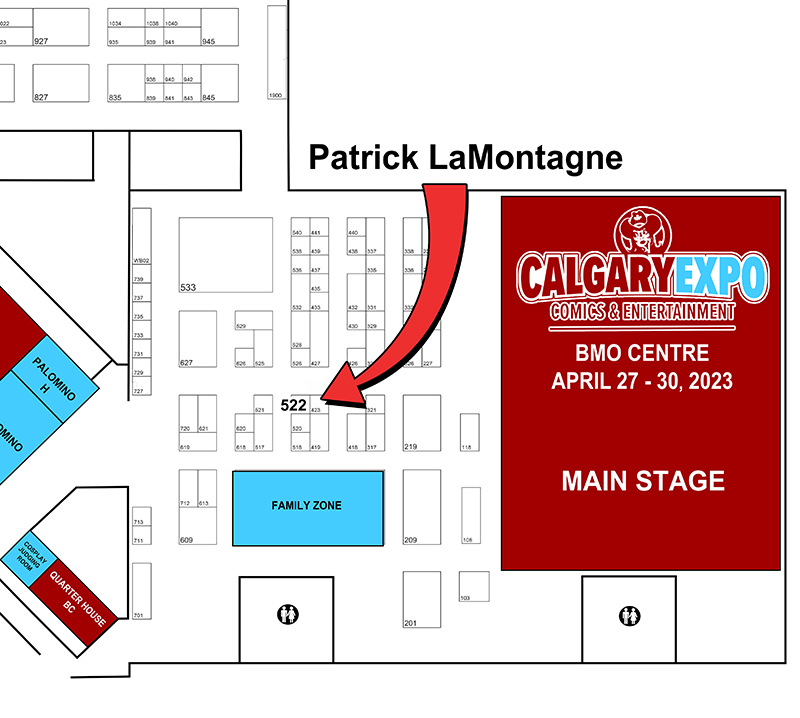


 When I started drawing
When I started drawing